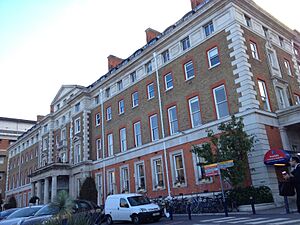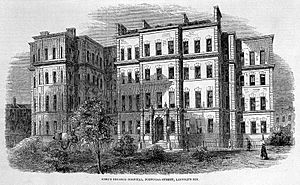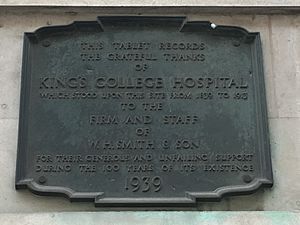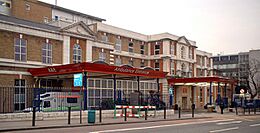King's College Hospital facts for kids
Quick facts for kids King's College Hospital |
|
|---|---|
| King's College Hospital NHS Foundation Trust | |

King's College Hospital main entrance in 2015
|
|
| Lua error in Module:Location_map at line 420: attempt to index field 'wikibase' (a nil value). | |
| Geography | |
| Location | Denmark Hill, Camberwell, London SE5 9RS, England |
| Organisation | |
| Care system | National Health Service |
| Hospital type | Teaching |
| Affiliated university | King's College London |
| Services | |
| Emergency department | Major Trauma Centre – (Adult and Children) |
| Beds | 950 |
| Speciality | Liver Disease, Neurology, Neurosurgery, Dentistry, Trauma (medicine) |
| History | |
| Founded | 1840, current site 1909 |
King's College Hospital is a very important hospital in London, England. People often call it "King's" or "KCH." It is a major teaching hospital, which means it helps train new doctors and nurses. It also has a special trauma centre for serious injuries.
The hospital serves many people in London, especially in the areas of Southwark and Lambeth. It also helps millions of people from other parts of southern England with very specific medical needs. King's College Hospital works closely with King's College London and is part of a group called King's Health Partners. Did you know that Queen Camilla was born at this hospital?
Contents
History of King's College Hospital
How King's Hospital Started
King's College Hospital first opened its doors in 1840. It was in an old workhouse building near King's College London. The hospital was a place where medical students from King's College could learn and practice.
The area around the hospital was very crowded and poor. Many people there were sick. Soon after opening, the hospital was treating many patients. Sometimes, two patients even had to share a bed! King's was also one of the first hospitals to start training nurses, beginning in 1856.
Important Medical Advances
A famous surgeon named Joseph Lister worked at King's. In 1877, he performed a major surgery using very strict antiseptic (germ-killing) methods. His work helped make King's a top hospital for surgery in Europe.
Moving to a New Location
In the early 1900s, more people were living outside central London. So, the hospital decided to move closer to its patients. In 1909, a new hospital building was started at Denmark Hill, south of the River Thames.
The new building was very modern for its time. It had good air flow and electric clocks. It even had one of the first internal phone systems in the UK! The hospital also made its own electricity using diesel engines.
King's Hospital During Wartime
During the First World War, a large part of the hospital was used to treat soldiers. It became the 4th London General Hospital. A special dental school was also set up there in 1923.
In those days, many patients were poor and could easily catch diseases like tuberculosis. In 1937, a special wing was added for wealthier patients. During the Second World War, the hospital treated people injured in air raids. Luckily, the hospital itself was never badly hit. Queen Camilla was born at King's College Hospital in 1947.
King's Hospital Today
After the National Health Service (NHS) started in 1948, King's became a teaching hospital. This meant it continued to be a key place for medical education. In 1983, the hospital's medical school joined back with King's College.
A modern learning centre, the Weston Education Centre, opened in 1997. It has a medical library and hosts many important medical events. In 1998, the medical schools of King's, Guy's, and St Thomas' hospitals joined together. This created a large medical school known as "GKT."
A new part of the hospital, the Golden Jubilee wing, was finished in 2002. It has clinics and therapy rooms for patients.
Hospital Facilities
King's College Hospital has several entrances. The Golden Jubilee Wing entrance is now the main one for most visitors. There is also a new entrance for the Accident & Emergency (A&E) department.
The hospital was one of the first to offer free Wi-Fi for everyone. This helps patients and visitors stay connected. In 2022, a new outpatient unit was built. It has many rooms for appointments and procedures.
Hospital Location
King's College Hospital is on Denmark Hill. Across the road is the Maudsley Hospital, which is a psychiatric hospital. They work closely together. The Institute of Psychiatry is also nearby. Doctors at King's often work with researchers there to study conditions like Parkinson's disease. The nearest train station is Denmark Hill railway station.
King's Hospital in Media
King's College Hospital has been featured in a popular TV show called 24 Hours in A&E. This documentary shows what happens in the hospital's emergency department. It uses many cameras to capture the busy work of the doctors and nurses.
Notable People from King's
Many important people have worked or studied at King's College Hospital. Here are a few:
- James W. Black – He won the Nobel Prize for Medicine in 1988 for his discoveries about how medicines work.
- Joseph Lister – He was a pioneer in using antiseptic methods during surgery, making operations much safer.
- Robert Daniel Lawrence – He helped start Diabetes UK, an important charity for people with diabetes.
- Robert Bentley Todd – He was one of the first to understand how electricity works in the brain. He also developed early ideas about epilepsy.
See also
- Healthcare in London
- List of hospitals in England
- King's Health Partners
- List of NHS trusts
- Guy's Hospital
- Maudsley Hospital
- St Thomas' Hospital
- King's College London GKT School of Medical Education





